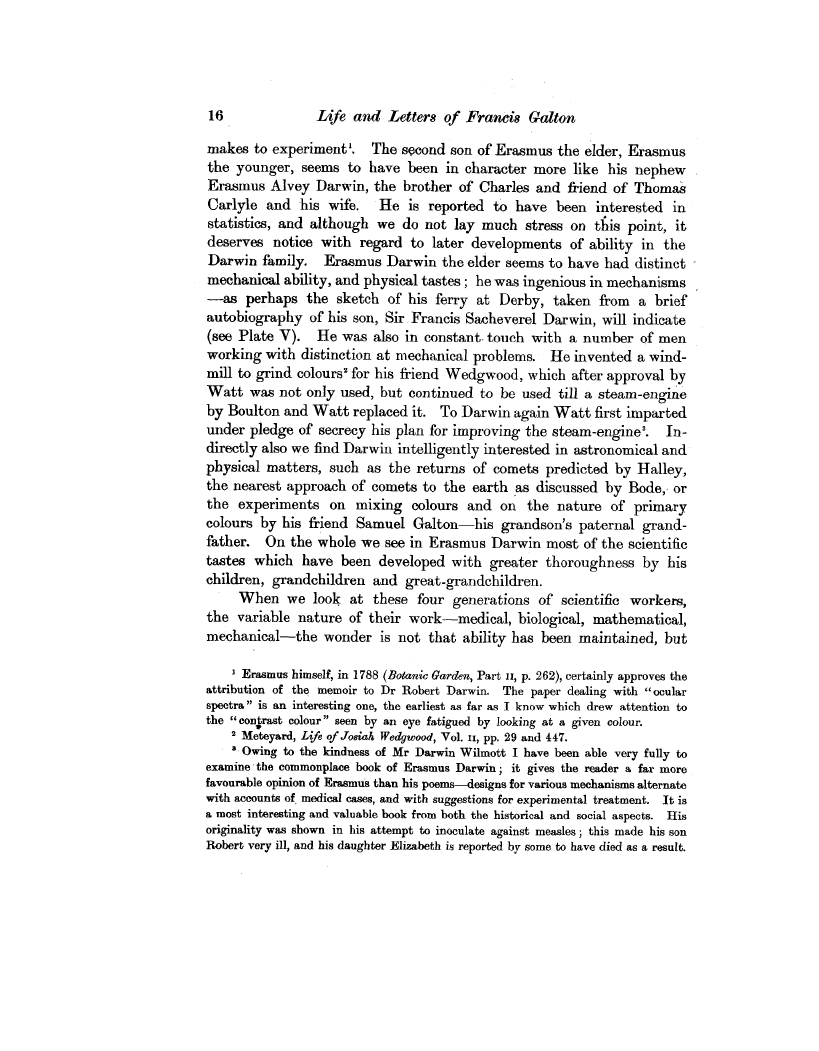| ||||||

OCR Rendition - approximate
16 Life and Letters of Francis Galton makes to experiment'. The second son of Erasmus the elder, Erasmus the younger, seems to have been in character more like his nephew Erasmus Alvey Darwin, the brother of Charles and friend of Thomas Carlyle and his wife. He is reported to have been interested in statistics, and although we do not lay much stress on this point, it deserves notice with regard to later developments of ability in the Darwin family. Erasmus Darwin the elder seems to have had distinct mechanical ability, and physical tastes ; he was ingenious in mechanisms -as perhaps the sketch of his ferry at Derby, taken from a brief autobiography of his son, Sir. Francis Sacheverel Darwin, will indicate (see Plate V). He was also in constant touch with a number of men working with distinction at mechanical problems. He invented a windmill to grind colours2 for his friend Wedgwood, which after approval by Watt was not only used, but continued to be used till a steam-engine by Boulton and Watt replaced it. To Darwin again Watt first imparted under pledge of secrecy his plan for improving the steam-engine. Indirectly also we find Darwin intelligently interested in astronomical and physical matters, such as the returns of comets predicted by Halley, the nearest approach of comets to the earth as discussed by Bode, or the experiments on mixing colours and on the nature of primary colours by his friend Samuel Galton-his grandson's paternal grandfather. On the whole we see in Erasmus Darwin most of the scientific tastes which have been developed with greater thoroughness by his children, grandchildren and great-grandchildren. When we look at these four generations of scientific workers, the variable nature of their work-medical, biological, mathematical, mechanical-the wonder is not that ability has been maintained, but ' Erasmus himself, in 1788 (Botanic Garden, Part ii, p. 262), certainly approves the attribution of the memoir to Dr Robert Darwin. The paper dealing with "ocular spectra" is an interesting one, the earliest as far as I know which drew attention to the "contrast colour" seen by an eye fatigued by looking at a given colour. 2 Meteyard, Life of Josiah Wedgwood, Vol. ii, pp. 29 and 447. a. Owing to the kindness of Mr Darwin Wilmott I have been able very fully to examine the commonplace book of Erasmus Darwin ; it gives the reader a far more favourable opinion of Erasmus than his poems-designs for various mechanisms alternate with accounts of, medical cases, and with suggestions for experimental treatment. It is a most interesting and valuable book from both the historical and social aspects. His originality was shown in his attempt to inoculate against measles ; this made his son Robert very ill, and his daughter Elizabeth is reported by some to have died as a result.
|